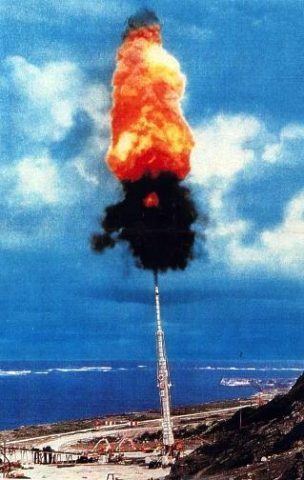 | ||
Project HARP, short for High Altitude Research Project, was a joint project of the United States Department of Defense and Canada's Department of National Defence created with the goal of studying ballistics of re-entry vehicles at low cost; whereas most such projects used expensive and failure-prone rockets, HARP used a non-rocket spacelaunch method based on a very large gun to fire the models to high altitudes and speeds.
Contents
Background
Started in 1961, HARP was created largely due to lobbying from Gerald Bull, a controversial but highly successful ballistics engineer who went on to head the project. Bull had developed the high-speed gun technique while working on anti-ballistic missile (ABM) and intercontinental ballistic missile (ICBM) research at CARDE in the 1950s, shooting models of high-speed interceptor missiles from guns as opposed to building supersonic wind tunnels, which would be much more expensive. The ABM project eventually ended without delivering a working system, but Bull was convinced the rocket systems he had developed had potential and started looking for other ways to use the technology.
The U.S. was in the process of testing newer ICBM systems and required repeated tests of newer re-entry vehicles. Bull suggested that the program could be run for considerably less money if the test vehicles were lofted from a large gun, as opposed to using rockets. This would also allow the test program's schedule to be greatly accelerated, as repeated firing was easy to arrange, compared to rockets. The key concept was the use of an oversized gun firing an undersized vehicle mounted in a sabot, allowing it to be fired with relatively high acceleration. Test electronics were potted in a mix of sand and epoxy, proving more than capable of withstanding the rigors of launch.
The project was based on a flight range of the Seawell Airport in Barbados at 13.077221°N 59.475641°W / 13.077221; -59.475641 (HARP Gun), from which shells were fired eastward toward the Atlantic Ocean using an old U.S. Navy 16-inch (410 mm), 50 Caliber gun (20 m); it was later extended to 100 caliber (40 m). In 1966 the project installed its third and final 16-inch gun at a new test site in Yuma, Arizona. On November 18, 1966 the Yuma gun fired a 400 lb (180 kg) Martlet 2 projectile at 7,000 ft/s (2,100 m/s) sending it briefly into space and setting an altitude record of 180 km (590,000 ft; 110 mi); that world record still stands as of 2013.
The program was canceled shortly after this and its assets were transferred to Bull under the title of the Space Research Institute, Inc. The politics of the Vietnam War (then in its fifth year) and soured Canada/U.S. relations played their role in the project's cancellation. The project received just over 10 million dollars during its lifetime. After the project was canceled the gun remained on its emplacement, where it remains to this day, gradually rusting away. A couple of used barrels and what appeared to be an unused barrel were also left there. Bull's goal was to fire a payload into space from a gun and many have suggested that the ballistics study was offered simply to gain funding. While the speed was not nearly enough to reach orbit (less than half of the 11,200 m/s delta-v required to reach low Earth orbit), it was a major achievement at much lower cost than most ballistic missile programs.
Project Babylon
Bull never abandoned the idea of a gun-fired satellite, but was forced to turn to other work. Through the 1970s and 1980s he developed a new artillery piece that dramatically outperformed all others. His design, the GC 45, attracted wide attention. Seeking customers, Bull sold the gun to South Africa and then to Iraq. He was arrested and jailed in the US for the sales to South Africa, and left Canada after his release to live in Brussels.
He then resumed work with Iraq, convincing them to build a new satellite launcher gun, Project Babylon. Saddam Hussein agreed to fund the project, but only if Bull helped with their efforts to re-design the re-entry vehicle of the Scud missiles to improve range. Bull agreed, making him an enemy of Iran and Israel, the intended target of the longer-range missiles. The March 1990 assassination of Bull (allegedly at the hands of the Israeli Mossad or the Iranian VEVAK intelligence agency) in his Brussels apartment, and the 1991 Gulf War ended the project.
Martlet projectiles
There were several models of test projectiles fired or designed during Project HARP:
